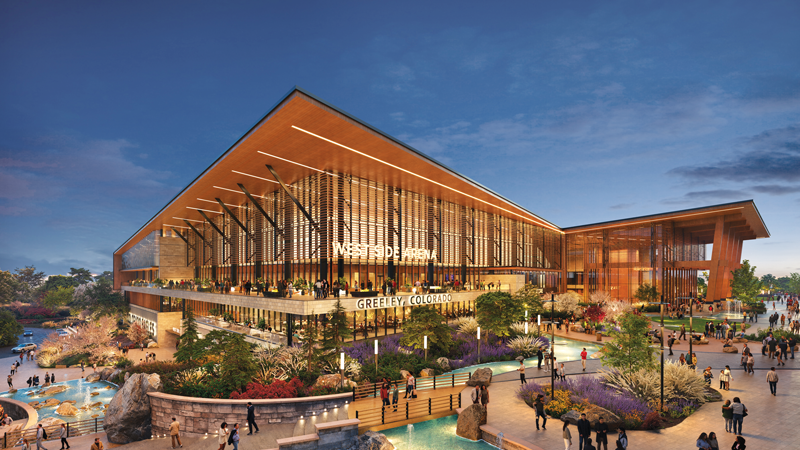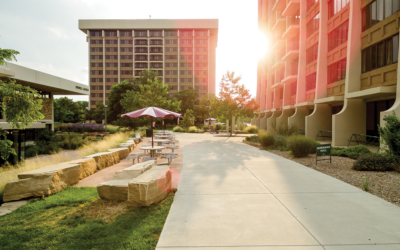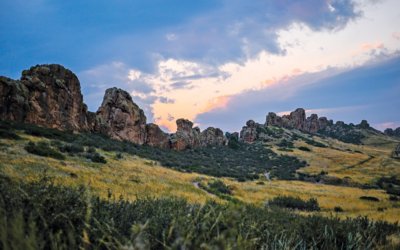Back when Martin Lind’s parents were young—he acknowledges that was a long time ago—Greeley was considered the king of Northern Colorado. It was a powerful force back when agriculture was the dominant moneymaker of the community.
“In my generation, they lost that status to Larimer County,” Lind says.
But now he’s working on something so big that it could transform Greeley, he says, both in the way it’s shopped and perceived. There are other signs that Greeley is entering a new era too, including another shopping center and some additional action downtown.
Inside the Eagles’ nest
The Water Valley Company’s glossy report calls its latest undertaking “Cascadia,” which would not only bring the Colorado Eagles to Greeley in a brand-new arena but also house concerts and other live events as well as a secondary arena for youth hockey leagues. It would be surrounded by a hotel and a 100,000-square-foot indoor water park (a concept made famous by the Great Wolf Lodge), plus a master-planned community with water features, miles of trails, restaurants, bars and top-notch retail shops.
“This would be a big tidal wave shift that would bring it all back to Greeley,” Lind says.
That’s exactly what the City of Greeley and its manager, Raymond Lee, had in mind when they asked to meet with Lind a couple years ago to talk about Greeley’s future. They liked Water Valley’s projects in Windsor, they told him, and wondered if they could do something similar but even bigger and bolder. The meeting was meant for Lind to be an advisor, not a developer, but when his plans for a similar development didn’t work out at The Ranch Events Complex in Loveland, Greeley was happy to welcome him in.
“I was honored,” Lind says of the meeting. “Rather than grow a quarter-mile at a time, they wanted a bold vision. It’s got the potential to change Greeley for sure.”
Cascadia is no longer just a vision. The city may review the plans this month, though the city council did express concerns at a recent meeting about the billion-dollar price tag of the project. Still, Lind hopes the arena and surrounding attractions will open by the summer of 2028.
“That’s fast,” Lind says, “but we’ve been working with people on this a long time. We had so much invested in Larimer County, but I do believe in fate.”
If all that wasn’t enough, the development’s resort would also feature more than 350 rooms, a spa and fitness center and a 65,000-square-foot entertainment complex with a 10,000-square-foot arcade. A convention center would sit next to the resort, and there are plans for a nearby transportation hub that could offer buses or a light rail, though Lind says the transportation plans may not get built in his lifetime.
“This has a lot of forethought into it, including moving people in ways other than a car,” Lind says. “It’s all cooked into the planning.”
Lind, who is the owner of the Eagles, uses a hockey legend’s quote to describe Greeley. The city is in a unique position, given how secure it is in water rights and how much prime development land is available to the west, two luxuries that many other cities in the region don’t have.
“Wayne Gretzky said, ‘Don’t go where the puck is; go where the puck’s going,’” Lind says. “I believe that’s west Greeley.”
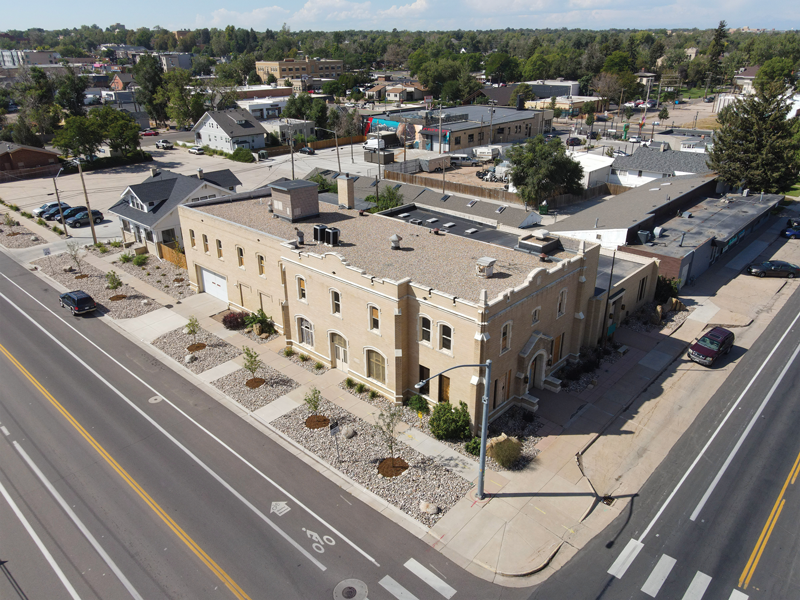
Greeley Creative District’s new home, a remodeled historic building, will provide studio space and make it easier for people to access the arts. Photo courtesy of the Greeley Creative District.
Greeley Creative District finds a new home
The founders of the Greeley Creative District started it in 2013 with a simple goal: They wanted to spotlight Greeley’s art scene, an asset that was overshadowed at the time by its agriculture. Now the district hopes to give itself a clearer identity with the purchase and renovation of its new, albeit historic, building.
The organization recently bought the 105-year-old Macy Allnutt Funeral & Cremation building within the boundaries of the creative district (essentially downtown Greeley), where the funeral home operated for many years before moving to west Greeley in 2019. The purchase includes a 1917 home that the creative district will rent out.
The district plans to rent space in the building to local creatives, build a gathering space and give itself a headquarters. The volunteer organization currently has no office space.
“The point of the building is it gives us a base from which to operate and make it even more possible for people to access the arts,” says Becky Safarik, founder and chairwoman of the board of directors. “Many artists and creatives are introverted individuals who find themselves working alone, but that doesn’t mean they don’t need community.”
The building should also make the creative district’s mission clearer to those who wondered what it did beyond put on a half-dozen events every year such as “DoTell!,” a storytelling performance, AgFeast and Día de los Muertos.
In 2012, the Colorado Office of Economic Development and International Trade was looking to expand the state’s reputation as much as Greeley wanted to expand its own. Colorado drew plenty of tourists who wanted to ski, climb its 14ers or sample its beer, but a study from the National Endowment for the Arts revealed that Colorado also ranked number one in the country in the percentage of residents who perform or create art.
As a result, the state started a program to foster Colorado Creative Districts, an opportunity that Safarik says was “too good to pass up.” Safarik, who spent decades as the City of Greeley’s director of planning before retiring as the assistant city manager, had a more unofficial title as “Greeley’s Biggest Cheerleader,” with Pam Bricker, who led Greeley’s Downtown Development Authority, as a close second. The two, along with Susan Nelson, the marketing director for the University of Northern Colorado’s nationally recognized visual and performing arts department, chose similar champions for the district’s first board, and the organization was certified by the state in 2014.
“The mission was super simple,” Safarik says. “We felt like Greeley has a rich cultural personality, and this was an opportunity to amplify that through a state megaphone.”
The district thought about obtaining a building for years, but it simply couldn’t afford one until Roy Wardell, a rancher and businessman from Platteville, contacted them about buying a building as a donation. His contribution of more than $1.5 million covered part of the purchase, and the district plans to kick off a capital construction campaign soon to cover the rest of the nearly $9 million needed to own the building and renovate it completely. It has enough, about $2.2 million, to cover phase one of the project, which affords it an office, gathering space and some rooms for artists. The district hopes phase one can be completed by this fall.
The district envisions hosting many of its current events in such a location along with providing a space to support the work of established and emerging artists and creatives, which will help them, and Greeley, reach their potential.
“We want people to understand that creativity is an important part of our existence,” Safarik says.
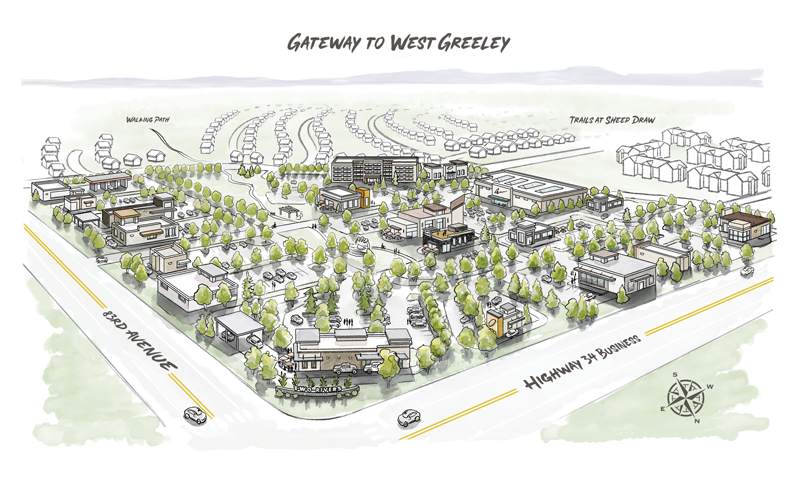
The Two Rivers Marketplace shopping center. Courtesy of Two Rivers Marketplace.
From family farm to shopping center
John Stephens worked as a developer for 20 years, and yet a single 29-acre plot of land in far west Greeley has stolen most of his attention during his career. That’s understandable, at least in part because it’s been in his family since 1970, when his father, David, purchased it to raise corn and cattle. The land sits off U.S. 34 Business and 83rd Avenue, a hot spot in fast-growing Greeley, and now the time has come to grow something else.
The Two Rivers Marketplace broke ground last August, and already there are roads that circle around the 19 retail lots. Stephens has two under contract, one for an auto parts store and another for a bank, and he’s pretty confident that a convenience store will sign on soon. The marketplace is probably the most significant commercial development since Centerplace of Greeley brought the area a Target, Safeway and other shops and restaurants on the corner of 47th Avenue and U.S. 34. Stephens says Two Rivers will be a bit smaller than Centerplace but that it’ll contain nicer amenities, including a greenbelt in the center that would be the perfect location for a few restaurants with outdoor patios.
Stephens also considered this property for years, if not decades, because it’s his first foray into commercial development after building residential homes.
“I’ve had this on the back burner for a long time,” he says. “We just had to wait for the right time.”

The Stephens Farm. Courtesy of the family.
He had to wait, in other words, for Greeley to grow west into 83rd Avenue, something his parents may not have guessed was possible in their lifetime. It doesn’t seem like that long ago when there were cornfields beyond 23rd Avenue, an area now considered smack-dab in the center of the city. And yet, Stephens recently took his mother, Sue, now 94, around the marketplace, and she marveled at the thousands of housing units that have sprung up (indeed, more than 15,000 new residences are under development in the area).
Stephens can’t help but dream up possibilities such as restaurants, a music venue and a pickleball facility (the latter of which has expressed serious interest). He’s also talking to mid-sized grocery stores and a smaller hotel. He believes at least one of the pads will have a completed building by the end of the summer.
“We want to infuse retail with a little bit of a stay-and-play kind of feel,” he says.
Stephens welcomes Lind’s plans to build a giant retail center in Greeley, anchored by the new Eagles arena. His parents remember a time when Greeley didn’t stretch beyond 23rd Avenue, but he sees a future where Greeley creeps up on Loveland’s borders.
“Activity begets activity,” he says.


